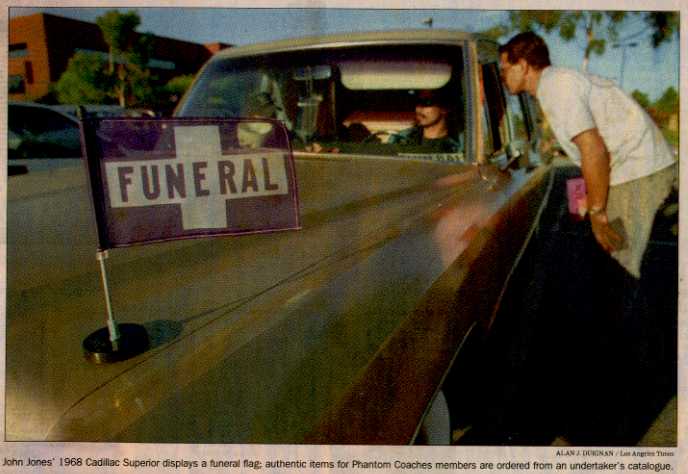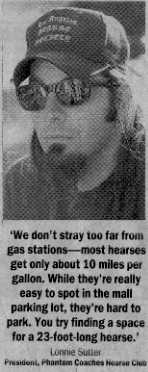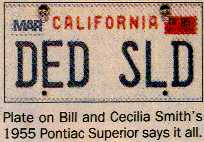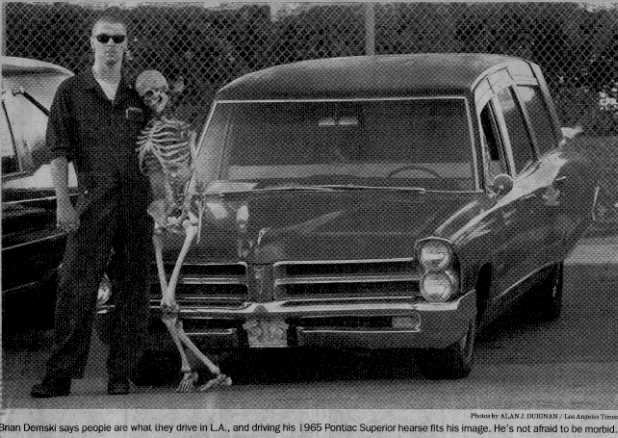
Mark Villarino leaps from the driver's seat, as though suddenly scared half to death.
There is one final detail - the last nail in the coffin, as it were, before the procession begins. "Oh!" says the chemist. "I almost forgot the funeral flags. Look at these things! A guy in the club ordered them from an undertaker's catalogue. They're totally cool."
But Villarino is not preparing for a funeral march. Dressed in tails, he slides back behind the wheel of his metallic blue 1968 Miller-Meteor hearse - the point car of another Sunday afternoon outing of the Phantom Coaches Hearse Club.
Featuring a dozen coaches in all, most festooned with the flapping purple funeral flags, all with headlights on, the procession pulls slowly out of Clover Park in Santa Monica, headed for - where else? - a nearby cemetery.
The ponytailed Villarino, donning a pair of ominous black sunglasses, is beside himself with excitement. He can't keep his eyes from his rearview mirror, cooing at the majestic-looking vehicles creeping slowly along behind him.
He notices the stupefied onlookers as well.
"Watch those cars stop for us," he says "See that guy scratching his head at the sight of a dozen old hearses passing by his house? This is so great."
In Southern California, being truly different is often a monumental task. Unless, of course, you own a secondhand hearse. There are three hearse clubs in the region, not to mention a San Francisco Bay Area group called Grim Rides.
As Halloween approaches, clubs like Phantom Coaches are on the road, in demand at haunted houses, Halloween supply stores and car shows.
Displaying their black funeral garb and even blacker humor, many hearses carry caskets and have horns that sound a funeral dirge. Phantom Coaches drivers cruise the Los Angeles area, edging past children who would no sooner cross their path than they would a mangy black cat's.
"It's like people are afraid of what's inside, of what the hearse represents," says Cecilia Smith, a 34-year-old Murietta bank officer and the club's secretary.
Even though they drive their coaches year-round, October is the time of year that owners have been, ahem, re-hearsing for.
"It's strange, "Villarino says. "During this time of the year, I get thumbs-up signs from people saying, 'Dude, cool car for Halloween!' But the rest of the year you just get grief for driving a hearse. People yell, "What are you, sick?' 'Are you a Satan-lover?' 'Get a life!' I guess it just comes with the territory."
Turning heads in the procession out of the park are the purple 1955 Pontiac end-loader, the 1962 Cadillac Superior and the elongated 1967 Cadillac Miller-Metor three-way - meaning, in funeral terminology, that it features three doors through which a casket can be loaded.

Then there's the baddest big-daddy coach of them all, the sleek black 1959 Cadillac Superior owned by Long Beach mortician and club member, Ronnie Grubbs.
The members just like the look of the vehicles that have carried thousands of dead bodies between them: the long, high-arching fins, velvet curtains and bullet-shaped brake lights - each hearse displaying that elegant, formal look in a spooky sort of way.
What they like even more, though, is observing public reaction to the cavernous-looking cars: The way traffic screeches to a halt and passersby gawk.
"If you enjoy attention, this is the car to drive," Villarino says. "I don't have to own a $75,000 Jaguar, just this old hearse. For the amount of attention you get per dollar, it's the best buy in town.
Lounging on the grass of the crowded city park - talking of Wes Craven horror flicks and twisted Far Side cartoons - they look like a resurrected 1960's rock band in their black T-shirts and jeans, tattoos and body piercing: nose rings, lip rings, even tongue rings.
Their diverse ranks include the hippest urban loners and couples form the dark heart of suburbia - such as the single mother with a 7-year-old son whose hearse is her only mode of transportation and the Murietta couple who got married in a cemetery.
There's the Corona family that travels with a 14-year-old daughter who likes hearses "because they scare people." And the furniture-maker with the shaved head who drives a funeral coach for one simple, Beavis and Butthead-esque reason: "Being morbid is cool."
They're all drawn together by the love of owning creepy, put-out-to-pasture vehicles costing anywhere from $500 to $10,000.
"They're great for moving large pieces of furniture and to amaze your friends," Smith says. "Most of all, though, they're unique, well-cared-for cars that for the most part have really low mileage - driven just to and from the cemetery is all."
There are, of course, drawbacks to owning your own used hearse: Other than being flipped off by the occasional unamused motorist, there are the old ladies who shake their fist from the sidewalk, telling you to "get closer to God."

And: "We don't stray too far from gas stations - most hearses get only about 10 miles to the gallon," says Lonnie Sutter, a 33-year-old film editor and club president, or "Chairman of the Morgue." "While they're really easy to spot in the mall parking lot, they're hard to park. You try finding a space for a 23-foot-long hearse.
But coach owners like the white-as-a-ghost reactions of passengers who can't appreciate the aesthetics of a secondhand hearse replete with its own once-used casket. "Once I took my godmother for a ride," René Ochoa says. "All she just kept saying was, 'I can't believe I'm riding in a hearse. But at least I'm up here in the front seat and not back there.'"
Villarino has used his hearse to bury his former nursery-school teacher, an elderly man who fell in love with his vehicle. "His wife thought it would be nice if I drove him to the cemetery," he recalls. "Now, I'm wearing his old tuxedo."
Ronnie Grubbs, who sells refurbished hearses for reuse in countries including Russia, France and South Africa, bought his 1959 Cadillac for $3000 from members of a now-defunct Orange County rock band called "The Die Hards," who for five years used the coach as an equipment mover.
As he talks, a group of school girls approaches Grubbs' hearse, giggling as they peer in the windows, noses pressed against the glass, asking, "Do you have a real dead body in there?"
But there's dissension in the ranks: Janis Dority of Corona shakes her head over her husband, Bob, dressed in a black top hat and boser shorts with a skull-and-crossbones design.
Then there's his oversized play toy, a hearse featuring purple running lights, a strobe-lighted casket and a horn that cries "Please help me!"
"They need attention, that's their problem," she sighs about club members. "They're exhibitionists, legal flashers."

Meanwhile, the hearse procession - bearing license plates such as "DA HERSE," "I MORBID" and "BLDNGOR" - makes its way toward its first stop - nearby Woodlawn cemetery - where members stand among the grave sites, absorbing the atmosphere.
There's a moment of tension when two park rangers pull up alongside the group - past processions have been harassed by police, club members say - until officers begin asking gee-whiz questions about the coaches.
One lights his flashers and whoops his siren for Dority, who carries a video camera.
"Go ahead," somebody says. "Wake the dead."
At another lot, as group members line up their hearses, people gather to watch: "you gotta be kind of bent," says Jeni Claunch of the owners before snapping a few photographs.

Waxing down his hearse, baldheaded Brian Demski says he's not afraid to be morbid.
He pauses before answering the question he's heard a thousand times.
"I own this thing because it fits my image. They say that in L.A., you are what you drive. Well, I drive a hearse. You figure it out.